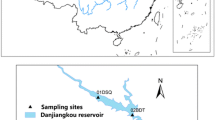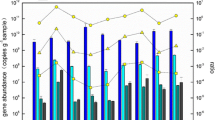Abstract
Ammonia oxidation plays a significant role in the nitrogen cycle in marine sediments. Seasonal and spatial distribution of ammonia-oxidizing archaea (AOA) and betaproteobacteria (β-AOB) in surface sediments from the East China Sea (ECS) were investigated using ammonia monooxygenase α subunit (amoA) gene. In order to characterize the community of AOA and β-AOB, real-time quantitative polymerase chain reaction (qPCR) was carried out in this study, along with environmental parameters. The abundance of β-AOB amoA gene (2.17×106–4.54×107 copy numbers per gram wet weight sediment) was always greater than that of AOA amoA gene (2.18×105–9.89×106 copy numbers per gram wet weight sediment) in all sampling stations. The qPCR results were correlated with environmental parameters. AOA amoA gene copy numbers in April were positively related to temperature and nitrite concentration (ρ<0.05). β-AOB amoA gene copy numbers in August correlated negatively with salinity (ρ<0.01), and correlated positively with ammonium concentration (ρ<0.05). With the increase of salinity, the amoA gene copy ratio of AOB to AOA had a tendency to decrease, which suggested β-AOB dominated in the area of high level ammonium and AOA preferred high salinity area.
Similar content being viewed by others
References
Brochier-Armanet C, Boussau B, Gribaldo S, et al. 2008. Mesophilic crenarchaeota: proposal for a third archaeal phylum, the Thaumarchaeota. Nat Rev Microbiol, 6(3): 245–252
Caffrey J M, Bano N, Kalanetra K, et al. 2007. Ammonia oxidation and ammonia-oxidizing bacteria and archaea from estuaries with differing histories of hypoxia. ISME J, 1(7): 660–662
Calvó L, Garcia-Gil L J. 2004. Use of amoB as a new molecular marker for ammonia-oxidizing bacteria. J Microbiol Meth, 57(1): 69–78
Cao Huiluo, Hong Yiguo, Li Meng, et al. 2011a. Diversity and abundance of ammonia-oxidizing prokaryotes in sediments from the coastal Pearl River estuary to the South China Sea. Antonie van Leeuwenhoek, 100(4): 545–556
Cao Huiluo, Li Meng, Hong Yiguo, et al. 2011b. Diversity and abundance of ammonia-oxidizing archaea and bacteria in polluted mangrove sediment. Syst Appl Microbiol, 34(7): 513–523
Dang Hongyue, Li Jing, Chen Ruipeng, et al. 2010a. Diversity, abundance, and spatial distribution of sediment ammonia-oxidizing Betaproteobacteria in response to environmental gradients and coastal eutrophication in Jiaozhou Bay, China. Appl Environ Microb, 76(14): 4691–4702
Dang Hongyue, Luan Xiwu, Chen Ruipeng, et al. 2010b. Diversity, abundance and distribution of amoA-encoding archaea in deep-sea methane seep sediments of the Okhotsk Sea. FEMS Microbiol Ecol, 72(3): 370–385
Dang Hongyue, Zhang Xiaoxia, Sun Jin, et al. 2008. Diversity and spatial distribution of sediment ammonia-oxidizing crenarchaeota in response to estuarine and environmental gradients in the Changjiang Estuary and East China Sea. Microbiology, 154(Pt 7): 2084–2095
Di H J, Cameron K C, Shen J P, et al. 2009. Nitrification driven by bacteria and not archaea in nitrogen-rich grassland soils. Nat Geosci, 2(9): 621–624
Feng Biwei, Li Xiaoran, Wang Jinhui, et al. 2009. Bacterial diversity of water and sediment in the Changjiang estuary and coastal area of the East China Sea. FEMS Microbiol Ecol, 70(2): 236–248
Francis C A, Roberts K J, Beman J M, et al. 2005. Ubiquity and diversity of ammonia-oxidizing archaea in water columns and sediments of the ocean. P Natl Acad Sci USA, 102(41): 14683–14688
Gong G C, Lee Chen Y L, Liu K K. 1996. Chemical hydrography and chlorophyll a distribution in the East China Sea in summer: implications in nutrient dynamics. Cont Shelf Res, 16(12): 1561–1590
Han Minqi, Li Zhiyong, Zhang Fengli. 2013. The ammonia oxidizing and denitrifying prokaryotes associated with sponges from different sea areas. Microb Ecol, 66(2): 427–436
Head I M, Hiorns W D, Embley T M, et al. 1993. The phylogeny of autotrophic ammonia-oxidizing bacteria as determined by analysis of 16S ribosomal RNA gene sequences. J Gen Microbiol, 139(Pt 6): 1147–1153
Hong Yiguo, Wang Youshao, Chen Feng. 2013. Archaea dominate ammonia oxidizers in the Permian water ecosystem of Midland Basin. Microbes Environ, 28(3): 396–399
Hou Jie, Cao Xiuyun, Song Chunlei, et al. 2013a. Predominance of ammonia-oxidizing archaea and nirK-gene-bearing denitrifiers among ammonia-oxidizing and denitrifying populations in sediments of a large urban eutrophic lake (Lake Donghu). Can J Microbiol, 59(7): 456–464
Hou Jie, Song Chunlei, Cao Xiuyun, et al. 2013b. Shifts between ammonia-oxidizing bacteria and archaea in relation to nitrification potential across trophic gradients in two large Chinese lakes (Lake Taihu and Lake Chaohu). Water Res, 47(7): 2285–2296
Jin Tao, Zhang Tong, Ye Lin, et al. 2011. Diversity and quantity of ammonia-oxidizing Archaea and Bacteria in sediment of the Pearl River estuary, China. Appl Microbiol Biot, 90(3): 1137–1145
Junier P, Molina V, Dorador C, et al. 2010. Phylogenetic and functional marker genes to study ammonia-oxidizing microorganisms (AOM) in the environment. Appl Microbiol Biot, 85(3): 425–440
Könneke M, Bernhard A E, de la Torre J R, et al. 2005. Isolation of an autotrophic ammonia-oxidizing marine archaeon. Nature, 437(7058): 543–546
Kowalchuk G A, Stephen J R. 2001. Ammonia-oxidizing bacteria: a model for molecular microbial ecology. Annu Rev Microbiol, 55: 485–529
Li Maotian, Xu Kaiqin, Watanabe M, et al. 2007. Long-term variations in dissolved silicate, nitrogen, and phosphorus flux from the Yangtze River into the East China Sea and impacts on estuarine ecosystem. Estuar Coast Shelf S, 71(1–2): 3–12
Li Meng, Cao Huiluo, Hong Yiguo, et al. 2011. Spatial distribution and abundances of ammonia-oxidizing archaea (AOA) and ammonia- oxidizing bacteria (AOB) in mangrove sediments. Appl Microbiol Biot, 89(4): 1243–1254
Li Xiaoran, Xiao Yiping, Ren Wenwei, et al. 2012. Abundance and composition of ammonia-oxidizing bacteria and archaea in different types of soil in the Yangtze River estuary. Journal of Zhejiang University Science B (Biomedicine & Biotechnology), 13(10): 769–782
Limpiyakorn T, Sonthiphand P, Rongsayamanont C, et al. 2011. Abundance of amoA genes of ammonia-oxidizing archaea and bacteria in activated sludge of full-scale wastewater treatment plants. Bioresource Technol, 102(4): 3694–3701
Liu K-K, Peng T-H, Shaw P-T, et al. 2003. Circulation and biogeochemical processes in the East China Sea and the vicinity of Taiwan: an overview and a brief synthesis. Deep-Sea Research Part II: Topical Studies in Oceanography, 50(6–7): 1055–1064
Liu Zhenghui, Huang Shaobin, Sun Guoping, et al. 2011. Diversity and abundance of ammonia-oxidizing archaea in the Dongjiang River, China. Microbiol Res, 166(5): 337–345
Long Xien, Chen Chengrong, Xu Zhihong, et al. 2012. Abundance and community structure of ammonia-oxidizing bacteria and archaea in a temperate forest ecosystem under ten-years elevated CO2. Soil Biol Biochem, 46: 163–171
Mosier A C, Francis C A. 2008. Relative abundance and diversity of ammonia-oxidizing archaea and bacteria in the San Francisco Bay estuary. Environ Microbiol, 10(11): 3002–3016
Muβmann M, Brito I, Pitcher A, et al. 2011. Thaumarchaeotes abundant in refinery nitrifying sludges express amoA but are not obligate autotrophic ammonia oxidizers. P Natl Acad Sci USA, 108(40): 16771–16776
Rotthauwe J H, Witzel K P, Liesack W. 1997. The ammonia monooxygenase structural gene amoA as a functional marker: molecular fine-scale analysis of natural ammonia-oxidizing populations. Appl Environ Microb, 63(12): 4704–4712
Sahan E, Muyzer G. 2008. Diversity and spatio-temporal distribution of ammonia-oxidizing Archaea and Bacteria in sediments of the Westerschelde estuary. FEMS Microbiol Ecol, 64(2): 175–186
Santoro A E, Francis C A, de Sieyes N R, et al. 2008. Shifts in the relative abundance of ammonia-oxidizing bacteria and archaea across physicochemical gradients in a subterranean estuary. Environ Microbiol, 10(4): 1068–1079
Seitzinger S P. 1988. Denitrification in freshwater and coastal marine ecosystems: Ecological and geochemical significance. Limnol Oceanogr, 33(4, Part 2): 702–724
Sims A, Gajaraj S, Hu Zhiqiang. 2012a. Seasonal population changes of ammonia-oxidizing organisms and their relationship to water quality in a constructed wetland. Ecol Eng, 40: 100–107
Sims A, Horton J, Gajaraj S, et al. 2012b. Temporal and spatial distributions of ammonia-oxidizing archaea and bacteria and their ratio as an indicator of oligotrophic conditions in natural wetlands. Water Res, 46(13): 4121–4129
Spang A, Hatzenpichler R, Brochier-Armanet C, et al. 2010. Distinct gene set in two different lineages of ammonia-oxidizing archaea supports the phylum Thaumarchaeota. Trends Microbiol, 18(8): 331–340
Urakawa H, Kurata S, Fujiwara T, et al. 2006. Characterization and quantification of ammonia-oxidizing bacteria in eutrophic coastal marine sediments using polyphasic molecular approaches and immunofluorescence staining. Environ Microbiol, 8(5): 787–803
Vissers E W, Anselmetti F S, Bodelier P L E, et al. 2013. Temporal and spatial coexistence of archaeal and bacterial amoA genes and gene transcripts in Lake Lucerne. Archaea. 2013: 289478
Wang Jing, Wang Weidong, Gu Jidong. 2014a. Community structure and abundance of ammonia-oxidizing archaea and bacteria after conversion from soybean to rice paddy in albic soils of Northeast China. Appl Microbiol Biot, 98(6): 2765–2778
Wang Shanyun, Wang Yu, Feng Xiaojuan, et al. 2011. Quantitative analyses of ammonia-oxidizing archaea and bacteria in the sediments of four nitrogen-rich wetlands in China. Appl Microbiol Biot, 90(2): 779–787
Wang Xiaoyan, Wang Cui, Bao Linlin, et al. 2014b. Abundance and community structure of ammonia-oxidizing microorganisms in reservoir sediment and adjacent soils. Appl Microbiol Biot, 98(4): 1883–1892
Yao Huaiying, Gao Yangmei, Nicol G W, et al. 2011. Links between ammonia oxidizer community structure, abundance, and nitrification potential in acidic soils. Appl Environ Microb, 77(13): 4618–4625
Ye Lei, Zhu Guibing, Wang Yu, et al. 2011. Abundance and biodiversity of ammonia-oxidizing archaea and bacteria in littoral wetland of Baiyangdian Lake, North China. Acta Ecologica Sinica (in Chinese), 31(8): 2209–2215
Yin Qi. 2012. Microbial communities of the surface seawater in the South Pacific Gyre [dissertation]. Qingdao: Ocean University of China, 22
Zhang Bin, Sun Baosheng, Ji Min, et al. 2010. Quantification and comparison of ammonia-oxidizing bacterial communities in MBRs treating various types of wastewater. Bioresource Technol, 101(9): 3054–3059
Zhang Yao, Jiao Nianzhi. 2007. Dynamics of aerobic anoxygenic phototrophic bacteria in the East China Sea. FEMS Microbiol Ecol, 61(3): 459–469
Zheng Yanling, Hou Lijun, Liu Min, et al. 2013. Diversity, abundance, and activity of ammonia-oxidizing bacteria and archaea in Chongming eastern intertidal sediments. Appl Microbiol Biot, 97(18): 8351–8363
Zheng Yanling, Hou Lijun, Newell S, et al. 2014. Community dynamics and activity of ammonia-oxidizing prokaryotes in intertidal sediments of the Yangtze estuary. Appl Environ Microb, 80(1): 408–419
Author information
Authors and Affiliations
Corresponding author
Additional information
Foundation item: The National Natural Science Foundation of China under contract No. 40920164004; the National Basic Research Program (973 Program) of China under contract No. 2011CB403602; the Foundation for Innovative Research Groups of the National Natural Science Foundation of China under contract No. 41221004.
Rights and permissions
About this article
Cite this article
He, H., Zhen, Y., Mi, T. et al. Seasonal and spatial distribution of ammonia-oxidizing microorganism communities in surface sediments from the East China Sea. Acta Oceanol. Sin. 34, 83–92 (2015). https://doi.org/10.1007/s13131-015-0710-z
Received:
Accepted:
Published:
Issue Date:
DOI: https://doi.org/10.1007/s13131-015-0710-z




